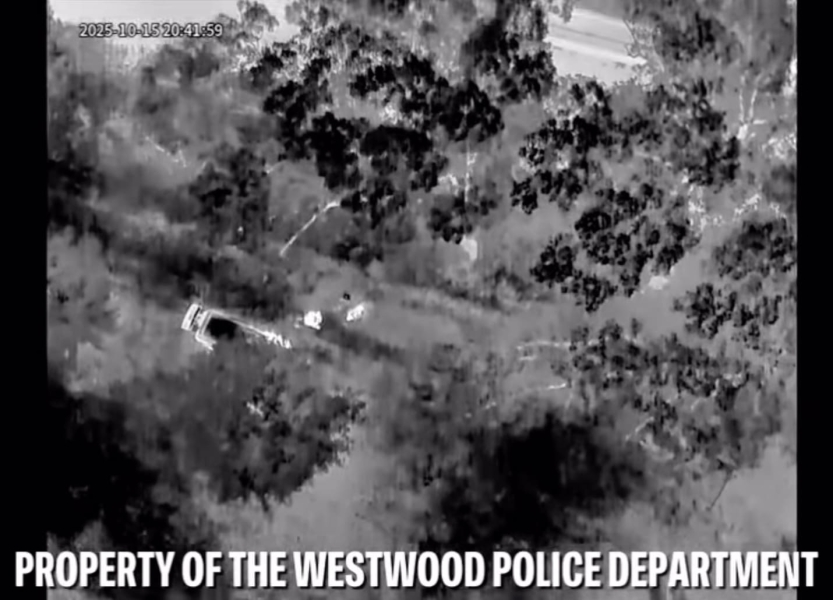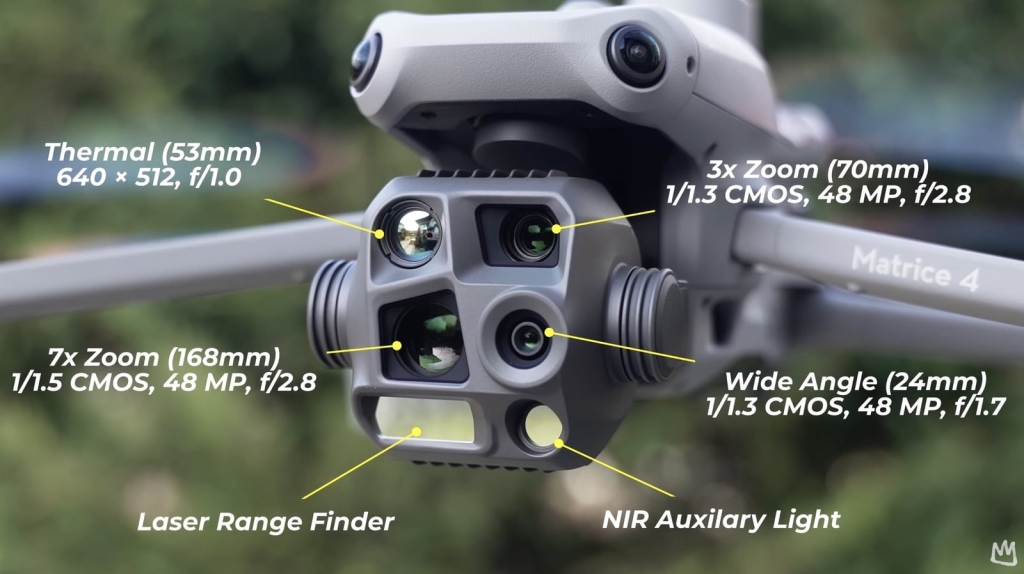Westwood Police Thermal Drone Locates Missing Person In Wooded Search And Rescue

A DJI Matrice 4T thermal-imaging drone helped the Westwood Police Department quickly locate a missing and endangered person in a densely wooded area on the evening of October 15, 2025. The successful rescue demonstrates why thermal cameras have become essential tools for law enforcement search and rescue operations.
The Westwood Police Department in Westwood Massachusetts shared details of the rescue on Instagram, describing how officers responded to a call for assistance for a missing and endangered person. When a police canine lost its track in a more populated area, responders made a critical decision: deploy the drone equipped with thermal imaging technology to search from above.
“Utilizing 21st-century technology, the Westwood Police Department deployed a drone with infrared capabilities, which located a heat signature along a wooded embankment,” the department stated in their post.
The missing person was located and received medical assistance before being transported to the hospital for evaluation. The coordinated effort between canine units, drone operators, and emergency services resulted in a safe outcome.
Why Thermal Imaging Changes Everything in Search and Rescue
When darkness falls or dense vegetation obscures vision, traditional search methods hit a wall. Ground-based teams can only cover so much terrain, and visual searches become nearly impossible at night. This is where thermal imaging fundamentally changes the rescue equation.
The DJI Matrice 4T features an uncooled vanadium oxide thermal sensor with 640 × 512 resolution, upgradable to 1280 × 1024 in super-resolution mode. This thermal camera detects human body heat against the much cooler surrounding environment—whether that’s cool water, forest floor, or night air. A person’s body temperature stands out as a bright heat signature that no amount of darkness or vegetation can hide.

The Matrice 4T’s thermal capabilities extend beyond basic detection. The drone includes infrared high-resolution mode with resolutions up to 1280×1024 pixels, offering detailed heat maps essential for locating individuals. The built-in near-infrared (NIR) auxiliary light illuminates subjects up to 100 meters away, providing additional clarity in complete darkness. This multi-layered thermal approach means rescuers can spot a person’s location with precision, even from hundreds of feet in the air.
Speed Saves Lives in Search Operations
In search and rescue scenarios, every minute matters. A thermal drone can cover the search area in minutes, compared to ground searches that might take hours or longer. The Westwood rescue illustrates this advantage perfectly. The canine unit worked the ground, but when the dog lost the scent in a populated area, the drone took over aerial coverage. Within the time it would take ground teams to spread out and search the woods systematically, the thermal camera identified the missing person’s location.
The Matrice 4T offers up to 49 minutes of flight time, giving search teams an extended window to cover terrain. The drone can hover over specific areas, pan across multiple sectors, and relay real-time information to command centers. This aerial intelligence transforms how emergency responders coordinate their ground efforts.
Real-World Application in Dense Terrain
Wooded embankments present particular challenges for traditional search methods. Vegetation provides cover and makes visual identification difficult, especially at night or in low-light conditions. The missing person in the Westwood incident was located along a wooded embankment—exactly the type of challenging terrain where thermal imaging proves indispensable.
Unlike visible-light cameras that become nearly useless in darkness or thick foliage, thermal sensors operate independently of ambient light. They simply detect heat, making them equally effective in daylight, dusk, or complete darkness. This capability has become standard equipment for law enforcement drone programs nationwide. Since 2018, approximately 1,500 law enforcement agencies have adopted drone programs, representing a 150% increase, with thermal imaging becoming the standard equipment for search and rescue drones.
Multi-Sensor Advantage
The Matrice 4T isn’t limited to thermal imaging. The drone features a 24mm wide-angle camera with a 1/1.3-inch CMOS sensor, a 3x medium tele camera, and a 7x telephoto lens, providing multiple viewing angles and detail levels. Once the thermal camera detected the heat signature, operators could switch to high-resolution visual cameras to confirm the person’s location and assess their condition before ground teams arrived.
The Matrice 4T also includes a laser rangefinder with a measurement range of 1,800 meters (5,905 feet), allowing operators to communicate precise coordinates to rescue teams. This multi-sensor approach transforms the drone from a simple detection tool into a comprehensive reconnaissance platform that guides first responders directly to the victim.
DroneXL’s Take
The Westwood Police rescue exemplifies why we champion thermal drone technology at DroneXL. This wasn’t a hypothetical scenario or a technology demonstration—it was a real person in genuine danger who went home safe because first responders had the right tools deployed at the right time.
What strikes us most about this rescue is how routine it’s becoming. Five years ago, only major metropolitan police departments could afford thermal drone technology. Today, the Westwood Police Department—serving a town of just over 13,000 residents—has this capability. The democratization of enterprise drone technology means that smaller departments can now conduct search and rescue operations that would have required expensive helicopter deployments or multi-hour ground searches in the past.
We’ve covered numerous successful water rescues, missing person cases, and disaster response operations where thermal drones arrived first and made the critical difference. From the Olean Police Department locating three kayakers on the Allegheny River just 11 days earlier to Atlantic City police using thermal drones to locate a man stranded in a marsh, the pattern is unmistakable: drones with thermal imaging save lives.
The Westwood rescue demonstrates that thermal cameras aren’t luxuries for elite tactical teams—they’re essential infrastructure for any police or fire department serious about search and rescue capability. As more incidents like this unfold across the country, we hope other departments take notice and invest in thermal drone programs before the next emergency call comes in.
What do you think about police departments using thermal drones for search and rescue? Share your thoughts in the comments below.
You can read more stories about Drones being used for Good right here on DroneXL.co
